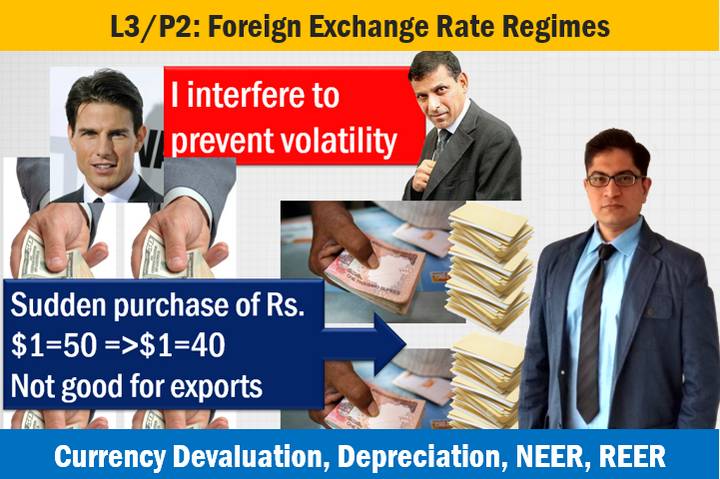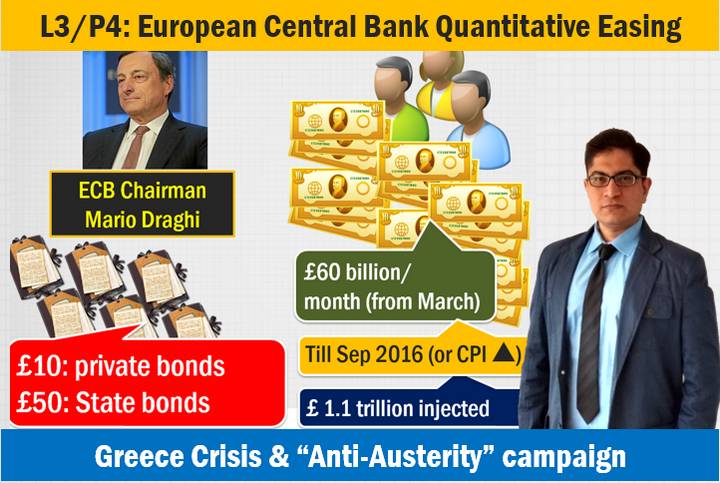- Prologue
- L3/P1: Balance of Payment (BoP) & Current Account Deficit
- L3/P2: Rupee Devaluation & Exchange rate regimes
- L3/P3: Capital account Convertibility & Tarapore Committee
- L3/P4: ECB quantitative easing & Greece Anti-Austerity
Prologue
- Sixth lecture was done on 20th February 2015, and uploaded on youtube. Total ~2:30 hours but I’ve split it into four parts.
- PowerPoint of the lecture, available at Mrunal.org/Download
- Medium of instruction- Hindi.
- English version not possible for the moment, because I’m required to teach at this batch, in Hindi/Gujarati only. Besides, same content is available in English-text articles and English PPTs on the site.
L3/P1: Balance of Payment (BoP) & Current Account Deficit

- Brief recap of the previous lectures
- What is balance of payment (BoP)? Definition, methodology.
- How is World’s balance of payment zero?
- How is India’s balance of payment zero? And if so, why did we have a balance of payment crisis in 1991?
- Two components of BoP: current account and capital account
- Components current account balance: visible and invisible part.
- Current Account: Services, income, transfer, gifts donations and remittances
- Concepts: Balance of trade, trade deficit and trade surplus. Major imports and exports of India.
- Calculating current account deficit and current account surplus.
- Difference between FDI and FII
- What is forex reserves? How is it built? What are the components of forex reserves?
http://youtu.be/oEq9VxPKLqI
L3/P2: Rupee Devaluation & Exchange rate regimes

- if $1=50 or $1=60: who decides this exchange rate and how?
- Fixed exchange rate regime: mechanism and limitations.
- Floating exchange rate regime: mechanism limitations.
- Difference between devaluation and depreciation of Rupee
- Difference between revaluation and appreciation of rupee?
- Historic trend of Indian rupee’s fall/weakening against US dollar
- How does devaluation of the currency boost its exports?
- Difference between NEER and REER? How does it help determining whether currency is undervalued or overvalued?
- “Managed” floating extended rate regime.
http://youtu.be/oRaSH1Zd4qQ
L3/P3: capital account convertibility

- What is “convertibility”? Why do we need to impose quantitative restrictions on convertibility between Indian rupee and foreign currency?
- What is “full” current account convertibility?
- What is capital account convertibility? Why does India have “partial” capital account convertibility?
- Under FEMA, What are the quantitative restrictions put on current account and capital account convertibility?
- What is capital account liberalization?
- Features of Liberalized remittance scheme (2004)?
- Arguments in favour and against of capital account convertibility and capital account liberalization.
- How did full capital account convertibility lead to collapse of East Asian economies in 1997?
- Recommendations of S.S.Tarapore Committee and why time not yet ripe for implementation of full capital account convertibility in India.
http://youtu.be/oTmHN3RVeT8
L3/P4: ECB quantitative easing & Greece Anti-Austerity

- Why does European Central bank (ECB) want to begin quantitative easing or Eurozone bond purchase program from March 2015?
- Mechanism of ECB-QE.
- Arguments in favour and against quantitative easing by ECB.
- How does it affect India’s economic interests?
- What is the Greece sovereign debt crisis?
- Why has ECB refused to incorporate Greece Bond purchase in its QE program?
- Why do Greek Leftist party “Syriza” and its leader Alexis Tsipras are pursuing “Anti-austerity” campaign?
- Possible implications if Greece leaves Eurozone?
http://youtu.be/MblO4eTeP3A





![[Summary] Budget & Economic Survey 2018 Gist for the UPSC IAS/IPS Interviews](https://mrunal.org/wp-content/uploads/2018/02/c-bes18-basanti-500x383.jpg)
![[BES171] Banking-Classification: Wholesale Banks, Cooperative Banks, DFI AIFI, MUDRA Bank, Islamic Bank, NBFCs & Indigenous Moneylenders](https://mrunal.org/wp-content/uploads/2017/05/c-bes171-evo-2-500x383.gif)
![[BES171] Banking-Classification: RBI Structure Functions, Nationalization, Scheduled Banks, Merger of SBI Associate Banks & BMB, Private Banks, SFB & Payment Banks](https://mrunal.org/wp-content/uploads/2017/02/c-bes171-cover-500x383.gif)
Sir,
I could not find english text articles. Could you send it to my mail or tell me how i will find.
sir, i am m.tech first year student .i wanna ask , how to improve english grammer .. any suggestations.
Sir.kindly post in English so that everyone can understand
Gurudev once you used to advise the volunteers who wished to post blogs on your website that the content should be easily accessible by GARIB 2G JUNTA also.
But now why such extreme shift in your welfare doctrine? Almost all your lectures are being posted as video lectures!!!
simple articles updates dete jaaon na yaar
kahe ko ye lecture baaji…?
everybody cant afford “3g connection” to see your lectures…
if there is article we can easily “scroll” down…
saves our time…
and we enjoy articles only…
please make available more such economics notes
i want to subsribe to mrunal current affairs,economics and other general studies papers
mrunal sir…plz answer ,,,i have turned 30 this feb. ..will i b eligible for upsc 2015..?…general category…female
Which book is better for human geography and world geography for upsc mains?
thanks alot sir , u made econmics a simple and easily digestable subject …….
i have a doubt sir,
it is said that to stop depreciation rbi sells dollar and it is also said that to stop weakening of rupee rbi has to stop outflow of dollar.
Isn’t it contradicting?
pls clarify sir
Please continue posting TEXT articles rather than posting videos because it helps in revising in exam time…We dont get enough time to watch full videos in last moment.
capital account convertibility book se padhke toh kuch kuch samajh me aaya tha, par aapke video lecture se pata chala ki woh kitna kam tha..conceptual clarity ke liye bahut dhanyavad Sir!
An english article on capital account convertibility please?
sir the ppt is not available on the link provided. pls help.
Thanks Sir ji you made economics very simple
Thnks